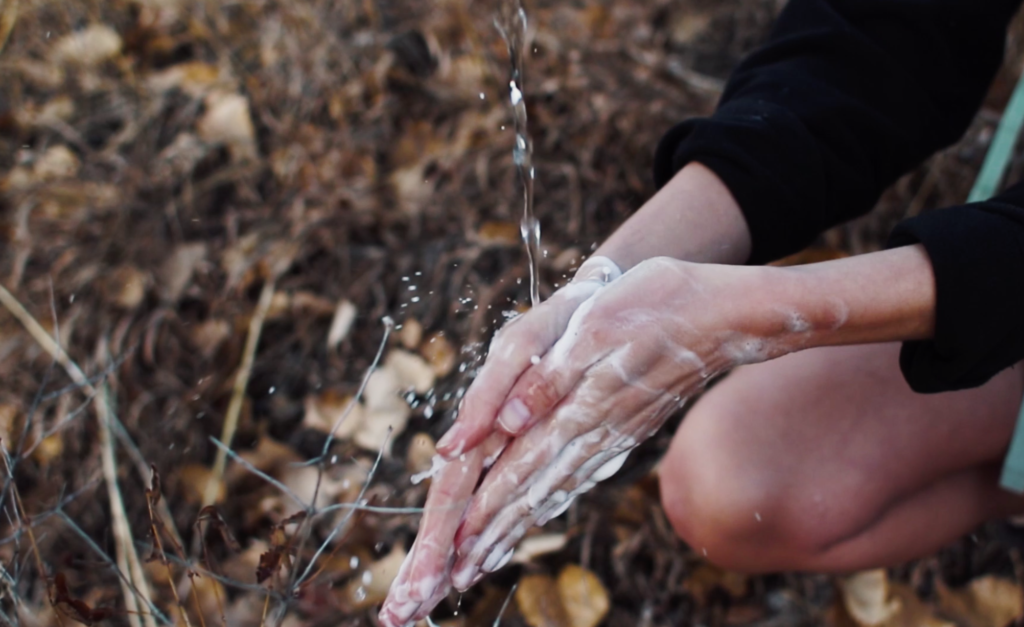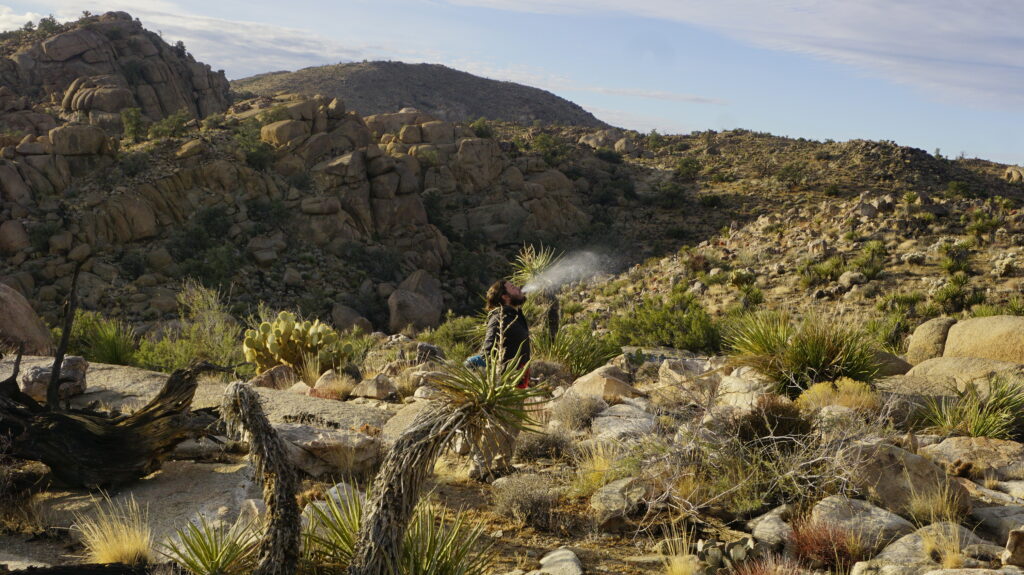Explore 10 hygiene practices to keep you clean and healthy in the backcountry.
Even if you enjoy getting dirty from a good long day spent outdoors, using the right practices in the backcountry means that you can stay clean and healthy even on extended wilderness expeditions. Today more than ever, we’re aware of using excellent hygiene practices. Below are 10 baseline practices to adopt on your next backcountry adventure.
1. Wash Your Hands
In the backcountry, like at home, always wash your hands with soap and water after using the bathroom and before touching food. An easy way to do this is to carry a dromedary with a pouring nozzle. In camp, hang the dromedary from a tree for a sink station.
When you’re on a trail, ask a friend to pour a stream of water for you by gently pouring water from a water bottle. Consider bringing along a high-concentration soap, so that a dot of soap can go a long way! Carry hand sanitizer and pack it in an accessible place when you’re on the go.

2. Dry Feet Are Happy Feet
When you get to camp for the night, change into a set of dry camp shoes. Check your feet for blisters and consider spending a few minutes having a ‘foot party’ as you eat a snack to let your feet air out. Some folks enjoy foot powder to reduce moisture either on arriving at camp or before you sleep at night.
3. Make Camp a “Clean Zone”
In camp, take precautions by keeping your living space clean. Avoid getting dirt and underbrush into your tent by brushing debris away from the area of entrance and designating a place to leave shoes outside. Learn more about setting up a simple, sturdy shelter here.
In your tent, keep a designated set of sleeping clothes inside of your sleeping bag, including socks and a cotton t-shirt. Cotton is great to sleep in because it is breathable, even while you may choose materials that are quick-dry and synthetic to wear during the day. Whatever you do, be sure to change out of your sweaty day clothes before jumping into bed!
4. Rinse, Brush, Scrub and Check
Before going to sleep, be sure to rinse your face and brush your teeth. Outward Bound groups often practice a dispersal method of spraying toothpaste, to avoid it landing in a huge clump. Every night should also include a thorough tick check. This can be a good chance to take note of any scrapes or wounds that need to be taken care of. Scrub your hands well in camp and be sure to keep your nails cut short to avoid dirt building up.

Disperse your toothpaste by blowing it out instead of spitting it out of your mouth.
5. Take Yourself and Your Clothing for a Dip
Backcountry Shower:
Depending on your environment, take the opportunity to dip in a body of water every day or every few days. In most places, you will need to follow Leave No Trace practices by not putting soap into your water source. To achieve this, take a dip to get wet, then walk away from the water source to use a bucket or pot to suds up and rinse off sponge bath-style. Remember, if your time is limited, the most important areas to clean regularly on an expedition are ‘pits and parts’!
Nature’s Washing Machine:
The limited clothing you carry on a multi-day backcountry trip is bound to get grimy, which calls for a laundry day. One of the best ways to prioritize cleanliness is to build in a rest day for your expedition, ideally a day that is sunny and windy. This is a day when you can camp in the same location, take the necessary time to thoroughly bathe and clean and dry your clothes.

Photo by Charis Nichols
Wash laundry in a similar style to bathing: wetting clothes in water and using a bucket or pot to suds and rinse away from the water source. Dispose of the dirty water by dispersing it preferably on dirt, away from water sources and not on plants. Paracord serves many functions in the outdoors, including as a drying line tied around two trees. No trees? No problem, clothes can also be left to dry on a sunny rock.
Pro tip: if you’re going on a multi-day backcountry trip invest in some quick-dry underwear, as it makes it quick and easy to frequently wash and dry your most important clothing piece.
6. Ditch the Deodorant and the Smell Goods, Seriously
Deodorant clogs pores, so it allows for more grime and sweat to get stuck when you’re using it without showering regularly. Highly fragranced products can attract insects. Instead, carry a high-concentrate soap that you can use for everything from washing dishes to pits!
For advice on more gear you don’t necessarily need in your pack, check out this blog.
7. Regularly Sanitize All Your Utensils and Eating Equipment
You can do this by boiling a pot of water and placing bowls and spoons inside on a continuous boil, or (for non-metal items), dipping cookware through the boiling water using a set of tongs.

8. Carry Out What You Carry In
Some of the products that we use to keep ourselves clean are manufactured and won’t break down in a wilderness environment. On Outward Bound courses, we often carry a ‘brown bag’ to be used for dirty wipes or menstrual products. You can find Bio bags for purchase or make your own with an opaque plastic bag that seals. Another option is to use a larger plastic bag inside of a paper bag. Every time you deposit something in the plastic bag, make a knot to seal it off and prevent it from smelling. The paper bag keeps things discreet.
These are all great ways to collect products before throwing the whole bag into the trash when you get back into the front country. Many folks also consider re-usable menstrual products, preventing the need to carry out trash.
9. Get Comfortable Going to the Bathroom on Expedition
Hygiene practices for using the bathroom vary depending on the environment that you’re traveling through. Good practices always involve having a designated plan and location for human waste. This plan could be a cathole if you’re in the woods, a composting toilet if you’re at a campsite, or a bucket with a seat if you’re on a sailboat.
Looking for further reading on how to go in the woods? Check out Serious Business: How to Poop in the Backcountry.
Having a plan for waste disposal ensures that no human waste contaminates water sources and that only compostable materials are properly disposed of in the environment. It’s healthy to get comfortable talking with your expedition-mates about going to the bathroom in the outdoors, to ensure that everyone is feeling good and following best practices.
10. Sweep It
One of the wonders of multi-day and multi-week backcountry trips is that we become immersed in our environment. Keeping ourselves clean means keeping the spaces that we travel through clean, too. One way to ensure that no mess is being left behind is to designate a ‘sweep’ in the group. A sweep is when one person scans the area of a campsite or break spot before departing and cleans up any remnants of the group’s presence.
Staying Clean Outdoors
Learning to stay clean in the outdoors can be one of the most empowering wilderness skills of all because it allows us to take bolder and longer trips to new environments while feeling comfortable and healthy. When you get a hang of the nuts and bolts of keeping clean in one wilderness setting, many best practices become transferrable and allow us to travel far and wide.
Discover more backcountry tips and tricks in The Beginner’s Guide to the Backcountry.
About the Author
Nora Spicer has instructed backpacking and canoeing courses at the Hurricane Island Outward Bound School since 2014. She has an MA in Environmental History from Harvard University and teaches Place-based US History (honoraspicer.com).
OTHER POSTS YOU MAY LIKE
Read More
Read More
Read More




